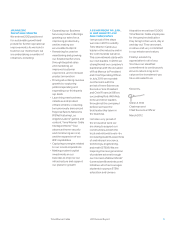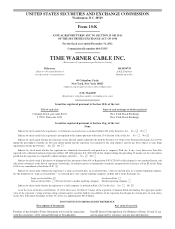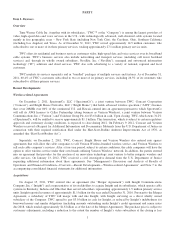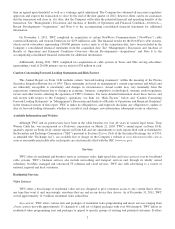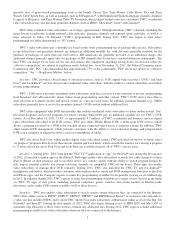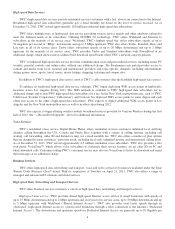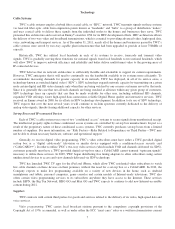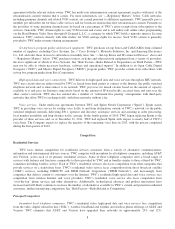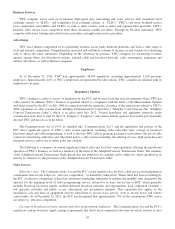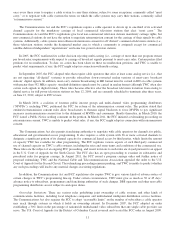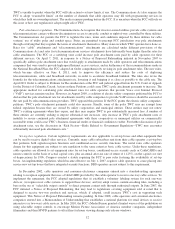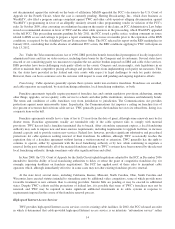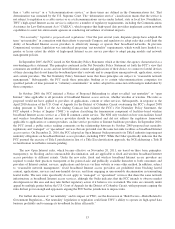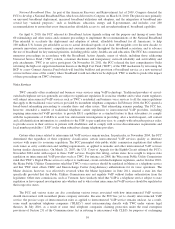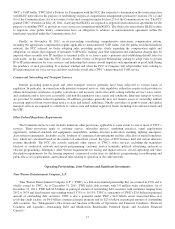Time Warner Cable 2011 Annual Report Download - page 15
Download and view the complete annual report
Please find page 15 of the 2011 Time Warner Cable annual report below. You can navigate through the pages in the report by either clicking on the pages listed below, or by using the keyword search tool below to find specific information within the annual report.Technology
Cable Systems
TWC’s cable systems employ a hybrid fiber coaxial cable, or “HFC,” network. TWC transmits signals on these systems
via laser-fed fiber optic cable from origination points known as “headends” and “hubs” to a group of distribution “nodes,”
and uses coaxial cable to deliver these signals from the individual nodes to the homes and businesses they serve. TWC
pioneered this architecture and received an Emmy®award in 1994 for its HFC development efforts. HFC architecture allows
the delivery of two-way video and broadband transmissions, which is essential to providing advanced video, high-speed data,
voice, networking and transport services. As of December 31, 2011, nearly all of the homes and businesses passed by TWC’s
cable systems were served by two-way capable plant infrastructure that had been upgraded to provide at least 750MHz of
capacity.
Historically, TWC has utilized local headends in each of its systems to receive, transcode and transmit video
signals. TWC is gradually moving these functions for national signals from local headends to two national headends, which
will allow TWC to improve network efficiency and reliability and better deliver multi-format video to the growing array of
IP-connected devices.
TWC believes that its network architecture is sufficiently flexible and extensible to support its current requirements.
However, TWC anticipates that it will need to continually use the bandwidth available to its systems more efficiently. To
accommodate increasing demands for greater capacity in its network, TWC has deployed, in all of its service areas, a
technology known as switched digital video (“SDV”). SDV technology expands network capacity by transmitting on a given
node certain digital and HD video channels only when they are being watched by one or more customers served by that node.
Since it is generally the case that not all such channels are being watched at all times within any given group of customers,
SDV technology frees up capacity that can then be made available for other uses, including additional HD channels,
expanded VOD offerings, faster high-speed data connections, reliable Digital Phone quality and interactive services. TWC
received an Emmy award in 2008 for its efforts in SDV technology development. In addition to its use of SDV technology,
TWC expects that over the next several years it will continue to reclaim spectrum currently dedicated to the delivery of
analog video signals, thereby freeing additional capacity for other services.
Set-top Boxes and IP-connected Devices
Each of TWC’s cable systems uses one of two “conditional access” systems to secure signals from unauthorized receipt.
The intellectual property rights to these conditional access systems are controlled by set-top box manufacturers. In part as a
result of the proprietary nature of these conditional access systems, TWC currently purchases set-top boxes from a limited
number of suppliers. For more information, see “Risk Factors—Risks Related to Dependence on Third Parties—TWC may
not be able to obtain necessary hardware, software and operational support.”
Generally, to receive digital video programming, TWC’s video subscribers must have either a TWC-provided digital
set-top box or a “digital cable-ready” television or similar device equipped with a conditional-access security card
(“CableCARDTM”). In order to utilize TWC’s two-way video services (which include VOD and channels delivered via SDV),
customers generally must have a TWC-provided digital set-top box since a CableCARD cannot transmit “upstream signals”
necessary to utilize these services. In 2009, TWC began distributing free tuning adaptors to allow subscribers using certain
unidirectional devices to access and view channels delivered via SDV technology.
TWC has launched TWC TV apps for the iPad and iPhone, which allow TWC residential video subscribers to watch
live cable channels on these devices on their premises, without the need for a set-top box or a CableCARD. In 2012, the
Company expects to make live programming available on a variety of new devices in the home, such as Android
smartphones and tablets, personal computers, game consoles and certain models of Internet-ready televisions. TWC also
offers certain video programming services to its subscribers anywhere they have access to the Internet. These services
include ESPN, the Big Ten Network, HBO GO and Max GO and TWC expects to continue to add new Internet-accessible
content during 2012.
Suppliers
TWC contracts with certain third parties for goods and services related to the delivery of its video, high-speed data and
voice services.
Video programming. TWC carries local broadcast stations pursuant to the compulsory copyright provisions of the
Copyright Act of 1976, as amended, as well as under either the FCC “must carry” rules or a written retransmission consent
7


